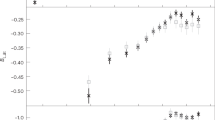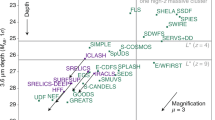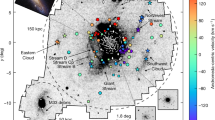Abstract
IT is widely accepted that the system of great nebulæ is at present in a state of uniform expansion, the relative velocity of recession between any two members of the system being proportional to their mutual distance. Thus we can write ½ = αr, where the coefficient α has, according to Hubble1, the value 3 × 10—17 sec.—1. If we accept also the uniformity of expansion with time, that is, if we suppose that the relative velocity of any two nebulæ is constant, we can easily calculate that about 109 years ago all nebulæ were side by side, that is, space was uniformly filled up with the stars. This epoch should thus be considered as the epoch of the formation of stellar accumulations known at present as great nebulæ.
This is a preview of subscription content, access via your institution
Access options
Subscribe to this journal
Receive 51 print issues and online access
$199.00 per year
only $3.90 per issue
Buy this article
- Purchase on Springer Link
- Instant access to full article PDF
Prices may be subject to local taxes which are calculated during checkout
Similar content being viewed by others
References
Hubble, E., "The Realm of Nebulæ" (Yale Univ. Press, 1936).
Jeans, J. H., "Astronomy and Cosmogony" (Cambridge Univ. Press, 1928).
Tolman, R. C., "Relativity, Thermodynamics and Cosmology" (Oxford University Press, 1938).
Author information
Authors and Affiliations
Rights and permissions
About this article
Cite this article
GAMOW, G., TELLER, E. The Expanding Universe and the Origin of the Great Nebulæ. Nature 143, 116–117 (1939). https://doi.org/10.1038/143116a0
Published:
Issue Date:
DOI: https://doi.org/10.1038/143116a0
This article is cited by
-
The Expanding Universe and the Origin of the Great Nebulæ
Nature (1939)
-
The Expanding Universe and the Origin of the Great Nebulæ
Nature (1939)
Comments
By submitting a comment you agree to abide by our Terms and Community Guidelines. If you find something abusive or that does not comply with our terms or guidelines please flag it as inappropriate.



